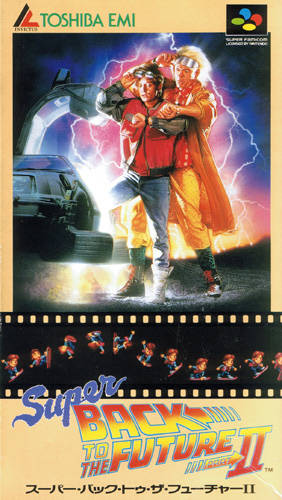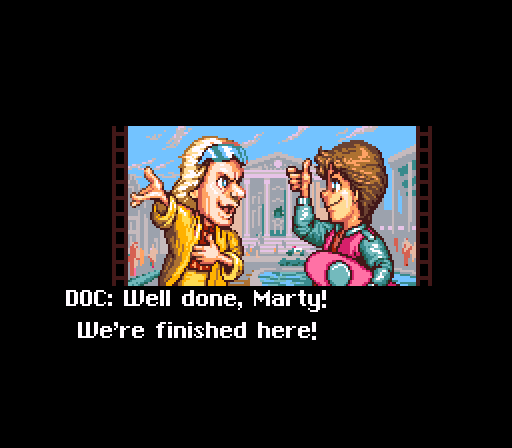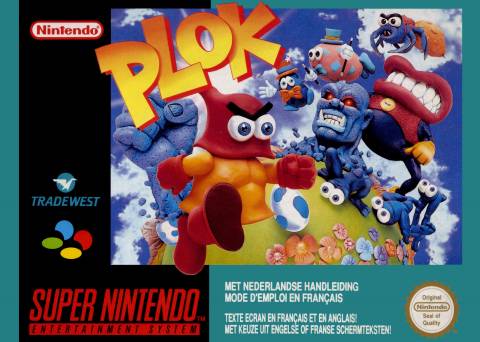The SNES Classic Mk. II: Episode XIII: Plok and Marty
By Mento 0 Comments
The SNES Classic had a sterling assortment of games from Nintendo's 16-bit star console, but it's hardly all that system has to offer a modern audience. In each installment of this fortnightly feature, I judge two games for their suitability for a Classic successor based on four criteria, with the ultimate goal of assembling another collection of 25 SNES games that not only shine as brightly as those in the first SNES Classic, but have equally stood the test of time. The rules, list of games considered so far, and links to previous episodes can all be found at The SNES Classic Mk II Intro and Contents.
Episode XIII: Plok and Marty
The Candidate: Daft's Super Back to the Future Part II

I'll admit to pencilling Super Back to the Future Part II in out of sheer curiosity after discovering it during my SNES GB Wiki days. Licensed games rarely go down well, especially Back to the Future ones for whatever reason, but I was hopeful that this one could rise above the risible LJN efforts due to its neat super deformed aesthetic and gameplay that reminded me a lot of Tiny Toons: Buster Busts Loose. The movie that this game is based on should require no introduction: Robert Zemeckis's Back to the Future Part II is the middle chapter of his Back to the Future trilogy, and debatably the most engaging of the three with its bewildering glimpses of a future that has already come and gone, and the way it goes all in on the franchise's time-travel conceit with its branching alternate presents/futures and paradoxes. It's the sci-fi geek's favorite of the three, at least, and the hoverboard alone makes it an alluring prospect for a video game adaptation.
Sadly, this game has a lot of problems, as might be reasonably expected from a movie license game from an unknown developer. This was Daft's first game, and they would later be known (if at all) for a series of "K-1" martial arts games in the PlayStation era. We'll be seeing them once more in this feature, so hopefully they'll have improved by then, but suffice it to say that they had some ideas that didn't quite pan out due to the cocktail of ambition and incompetence that frequently handicaps a developer's inaugural game. But first, I should time-travel back a few sentences and explain how this game plays.
Super Back to the Future II is what I've been calling a "momentum platformer". There were a spate of these following the success of Sonic the Hedgehog, where it was less about carefully picking through environments than hitting the acceleration in order to have enough speed to clear most of the larger jumps, as levels would inevitably branch off into "upper paths" that were harder to reach and tended to have better rewards, and "lower paths" which is where you'd often end up after missing the former and have an overall more precarious route to the finish line. Sonic popularized this particular format for platformers, but it started earlier with Kid Kool (and possibly even earlier than that with some unknown game), and it's never not been complete trash.

Simply put, you can't rush your way through Super Back to the Future II because of the frequency of trial-and-error bullshit by way of fast moving enemies and hazards flying in from the side of the screen, which are exacerbated further if you happen to be moving at full speed as well. You need to be careful to preserve your finite stock of energy and lives (and you'd better believe the game doesn't have any checkpoints, so guard those remaining hits fervently) by edging forward so that you aren't caught unawares. However, if you were hoping to find a level's secrets or easier routes, you'd need to fly pell-mell with the run button held down to successfully make the leaps of faith across wide chasms to reach them. The sheer arbitrariness of the game makes it better suited for repeated playthroughs: the game's sole merciful grace is that every stage in the game - standard and boss fights alike - have a password attached to them, meaning you can restart at any point of the game. However, these aren't short levels even once you know the most efficient route, and any mistake can send you hurtling back to the beginning.
It's a shame, because so much of the game is appealing on a purely superficial level. When it's not recreating that famous BTTF theme, it's coming up with some fine VGM jams of its own (it's a Sakimoto soundtrack! He really was everywhere), and I really adore the big-headed "chibi" treatment of the movie's characters, especially the even-more-manic Doc Brown (with his 2015 aviators and trenchcoat) and the various incarnations of Biff/Griff Tannen. It looks like the Japanese-American co-produced Saturday morning cartoon show adaptation that never was.
Talking of superficially cool but lacking in substance, it's time to bring out our stack of P.O.G.S. to see where this game lands in our high score table:
- Preservation: This one's for the morbidly curious only, I'm afraid. I can't in good conscience back the idea that old fake difficulty still has any cachet today, because it's not fair in the way most modern masocore games have to be. It looks cool and all, and I might even argue it's the best Back to the Future action game (in overall terms I think that Telltale series probably takes the crown), but it's been consigned to obscurity for a reason. 2.
- Originality: Well, it's a licensed platformer, so not too original. Even its momentum gaining gimmick has been lifted from better games. The cutscenes are disappointingly played straight, though there's some great reaction shots from the characters, and there's nothing here I would want to see continue in any modern capacity. 2.
- Gameplay: Oof, this is where the game really starts to lose powah. Actually playing the game feels abysmal in spots, but early on when the challenge level isn't so high it can be passably fun. The challenge level combined with the sluggish slope controls, the ease of missing valuable power-ups and safer routes, the cheap deaths from the sudden presence of enemies and hazards, and a complete lack of checkpoints all add up to a big, brown semi-solid mass that is waiting for Biff Tannen to crash right into it. 2.
- Style: I like the game's anime style and music, so this is the game's sole saving grace. I really hoped they could build a better game with these Puzzle Fighter-style BTTF characters, but it wasn't on the cards this time. Heavy, as Marty might say. 3.
Total: 9.
Other Images:
The Nominee: Software Creations's Plok

Plok is another game I'm pulling from of my Euro-centric background with the Super Nintendo Entertainment System, which for the whole part didn't have the sort of local success and presence that the Sega Mega Drive enjoyed with its many Amiga ports. Developed by Software Creations, a name so generic I forget it almost every time I bring them up (and has also appeared in this feature already with Equinox), Plok is from the outside looking in a run-of-the-mill mascot 2D platformer of the "scour the level for a finite number of enemies to eliminate" variety. It's colorful and friendly, like you'd expect from any mascot also-ran, and it has a sense of humor that - while it certainly hits more often than Bubsy - still adheres to a certain broad sensibility (to get very Britishy for a moment, it's very reminiscent of the weekly gag comic anthologies like Beano or Buster that kids used to buy). It's also really really difficult: there's few opportunities for extra continues and lives, and once they've both run out you're kicked back to the title screen.
Plok's true strengths become evident as you play, especially once you're past the straightforward introductory area Cotton Island. Aspects like how Plok tosses out his limbs to attack enemies which automatically float back to his body, how he can find and don various costumes that provide extra abilities for a brief time, how attacking crucial targets to make progress causes limbs to vanish until the player can reattach them greatly reducing his combat effectiveness (and, if all four limbs are gone, his mobility). The way the game gets about three stages into the "real" gameplay before it takes a break for a protracted, playable, sepia-toned flashback is remarkable also, if only for its audacity.

The game's greatest asset and the one has endured longest is the fantastic soundtrack. The Follins brothers put together a set of tracks that I can only classify as Looney Tunes meets Pink Floyd (it's probably an accident that "Plok" is almost a shortening of "prog rock", but what I'm supposing is: maybe it isn't?). The music can be breezy and cartoony one moment, and then go off on these extended melancholy riffs the next, and it's one of the most technically impressive soundtracks for the system with the way the Follins squeezed such rich-sounding music across so few sound channels. British devs have an underrated history of drawing out technological feats from the SNES - Argonaut Games wrangled a fully polygonal game out of the system with a little help from Nintendo and a special proprietary FX chip, while Rare helped establish the then-striking (though admittedly dated now) pre-rendered CGI look with Donkey Kong Country - and this is another example of that in action. Beach, Akrillic and Fleapit are some of the best musical offerings on a platform that didn't hurt for VGM bangers.
Like Final Fantasy Mystic Quest, I suspect this one's only really fondly remembered for its music, and that's all right. The game part is unreasonably difficult in parts and plodding in others, but I don't doubt the foundations set here for Plok, his world, his foes, and his abilities could've lead to some great sequels had the Pickfords (the directors, another team of two brothers) been allowed to continue with the character in later projects, especially if they kept the Follins around. Instead, they've moved into a Plok webcomic of all things, so it's heartening to know that Plok still lives on in some form at least. The 16-bit era saw a lot of bad mascots, and even more bad mascot platformers, but Plok (just about) manages to stay on the side of the angels. Man, if there were ever a game I wanted Arino to play on GameCenter CX...
But I'm putting the cart before the horse, here. Let's see what P.O.G.S. makes of the game:
- Preservation: Plok's graphical style can be boiled down to "gradient fills, and lots of 'em!", but it's a distinctive look and one that can allow for some really detailed environments and well-realized alternative suits for Plok, so I'd argue that graphically the game hasn't aged much at all. Obviously, the music is still as good today as it's always been. The difficulty's probably the killer here: finite continues were already on their way out by this era, and are even more antiquated today, but I suppose it still appeals to a certain masocore set. 3.
- Originality: There's no escaping the fact that Plok was playing follow the leader to some extent by releasing a colorful mascot platformer after the likes of Super Mario World, Sonic the Hedgehog, and even Bubsy had turned the conceit highly profitable. However, I'd also argue that the game is dripping with originality, from its aesthetic and character designs to the way it uses detachable limbs as weapons and costume changes as temporary power-ups. 4.
- Gameplay: I'm not normally one to dump on a retro game's difficulty because times were a lot harder back then, in more ways than one, but Plok really could've used a more generous continues system at the very least. It does have a difficulty toggle, but it's the sort of easier difficulty option that lifts huge swathes of content out of the game, which is always the worst. It has plenty of tricks, some clever boss fights, and the way your limbs float back to you after attacking is neat, but this is its weakest category for certain. 3.
- Style: The music alone bumps this category up to a 4, even if graphically the game doesn't do a whole lot for me. I did find it very amusing as a kid - there's a recurring subterranean enemy, Rockyfella, that tricks you with fake signs that have crude and insulting sketches of Plok on them, and he even insults you verbally at one point - which isn't something video games manage too often even today. 4.
Total: 14.
Other Images:












